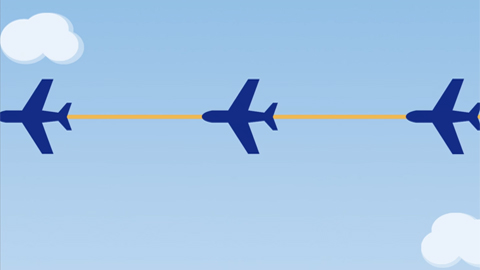The UAB leads two European projects to improve air traffic management

15/05/2017
Europe has one of the most transited air spaces in the world, with over 35,000 flights daily. In 2010, the European air traffic management (ATM) controlled some 9.4 million flights, a number which is expected to rise to 17 million flights by 2030, with daily peaks of 50,000 flights.
The European Union seeks to make this management system more efficient and capable of absorbing the future increase in traffic with a programme to fund Single European Sky ATM Research (SESAR) projects. The two projects underway, AGENT and PARTAKE, are led by the UAB and have the objective of developing information and communication technology-based tools which will provide a safer and more efficient air traffic management.
Project AGENT (Adaptive self-Governed aerial Ecosystem by Negotiated Traffic) will incorporate the intensive use of ICTs in order to equip aircrafts with better conflict resolution capacity. It proposes a new system with which to manage plane trajectories, through a tool which gives support to air traffic controllers and pilots in situations of conflict between planes and offers the possibility of choosing the best solution when changing trajectories according to the specific characteristics of each conflict.
“The technology developed will permit integrating aircraft separation tasks managed by air traffic controllers with airline preferences through cooperation mechanisms, with the objective of offering solutions that satisfy the interest of all parts involved. That will result in the possibility of creating new connections between cities, increasing flight frequencies and avoiding fuel consumption due to unnecessary manoeuvres, which will in turn reduce contaminating emissions and costs”, explains Miquel Àngel Piera, professor of the Department of Telecommunications and Engineering Systems at the UAB and coordinator of the project.
Project PARTAKE (cooPerative depArtuRes for a compeTitive ATM networK sErvice) will develop a tool to detect the optimal moment for take off in order to improve the efficiency of aircraft traffic. The system will aid in the decision-making process by prioritising the take-off of aircrafts which have already ended their layover and have the corresponding permit, taking into account not only the information on the airport - state of runways and plane movements - but also the impact plane trajectory can have for the rest of flights programmed in that air space. This aims to minimise the regular en route interventions by air traffic controllers to maintain the separation of aircrafts.
The system is based on the space-time analysis of flight plans requested by airlines, identifies air space areas where demands are greater to the capacity and adjusts take-off schedules.
“One must bear in mind that today, even if there is a large amount of data available in real time on the state of each airport, aircraft and air space sectors, as well as the prediction of how they will evolve, there are not tools helping us to analyse the space-time interdependencies between all actors”, explains Miquel Àngel Piera. “This tool will allow coordinating the departures of aircrafts from different airports and facilitate the en route separation tasks of air traffic controllers. Therefore, it will result in economic benefits for airlines and airports, improving punctuality in programmed landing hours”, he points out.
In addition to the UAB Department of Telecommunications and Systems Engineering, the projects include the participation of tech-based company Aslogic; Cranfield University, UK; the Braunschweig University of Technology,Germany in the case of AGENT, and the French Civil Aviation University, France, in the case of PARTAKE.
Towards a Single European Sky
The European programme SESAR was created to meet the demands of an integrated and common viewpoint on the evolution of the air traffic management system. It coordinates and concentrates all EU research and development activities conducted in this sector with the aim of creating one single EU air space, tripling its capacity, increasing its security, reducing air traffic costs by half and decreasing the environmental impact of flights.
Video of the AGENT project
Video of the PARTAKE project